BM414 Financial Decision Making: Analysis of SKANSKA Plc's Finance
VerifiedAdded on 2023/06/18
|13
|3865
|265
Report
AI Summary
This assignment provides a comprehensive analysis of financial decision-making within SKANSKA Plc, focusing on the application of management accounting techniques and financial ratios. It evaluates the role of accounting and finance functions in the company's operations, highlighting the use of financial planning, statement analysis, standard costing, budgetary control, and cash flow statements. The report includes a critical analysis of these techniques, acknowledging their benefits and limitations. Furthermore, it calculates and interprets key financial ratios such as Return on Capital Employed (ROCE), net profit margin, current ratio, and debtor/creditor days, assessing SKANSKA Plc's financial performance and efficiency. Desklib is your go-to resource for similar solved assignments and past papers.

Financial Decision-Making
Paraphrase This Document
Need a fresh take? Get an instant paraphrase of this document with our AI Paraphraser
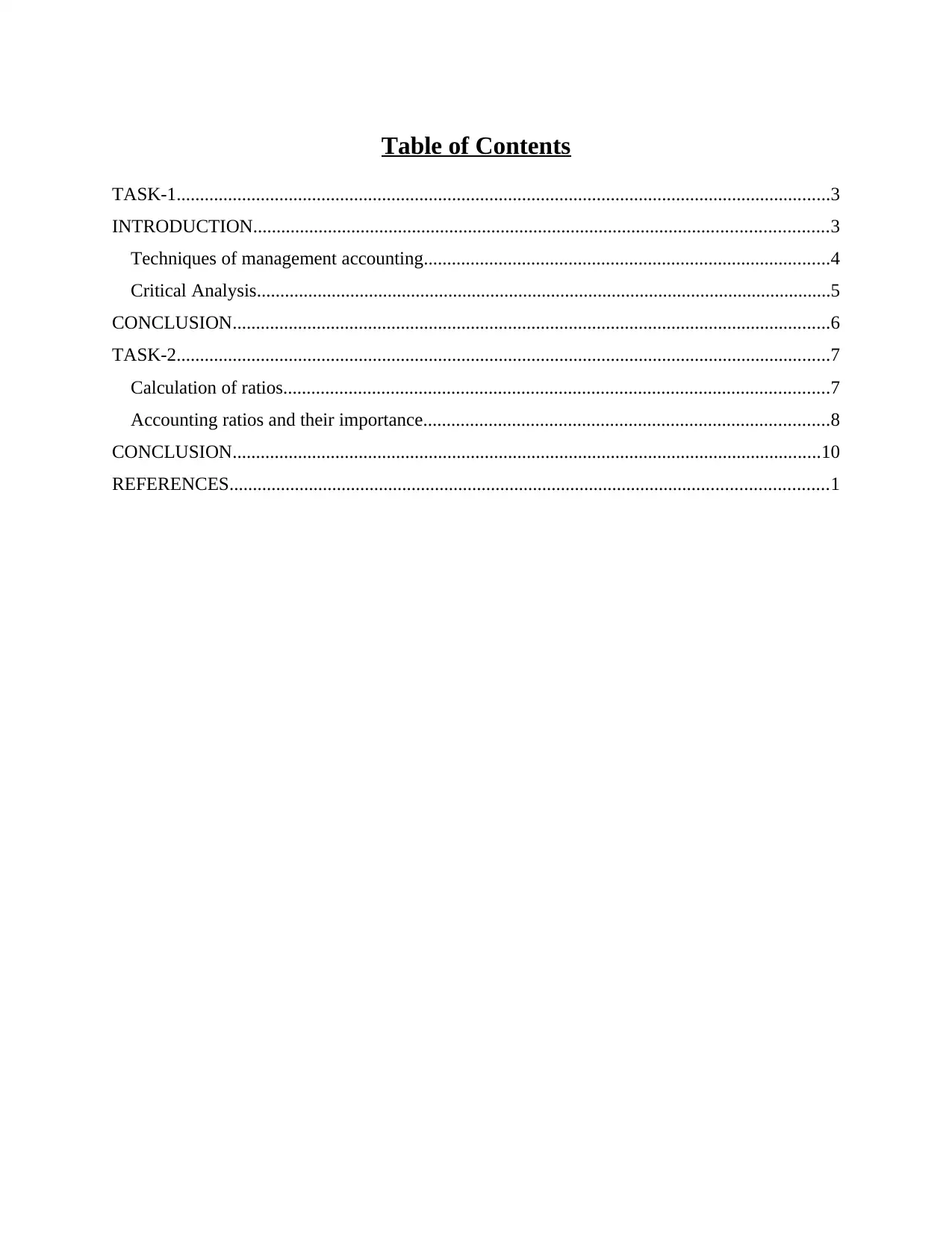
Table of Contents
TASK-1............................................................................................................................................3
INTRODUCTION...........................................................................................................................3
Techniques of management accounting.......................................................................................4
Critical Analysis...........................................................................................................................5
CONCLUSION................................................................................................................................6
TASK-2............................................................................................................................................7
Calculation of ratios.....................................................................................................................7
Accounting ratios and their importance.......................................................................................8
CONCLUSION..............................................................................................................................10
REFERENCES................................................................................................................................1
TASK-1............................................................................................................................................3
INTRODUCTION...........................................................................................................................3
Techniques of management accounting.......................................................................................4
Critical Analysis...........................................................................................................................5
CONCLUSION................................................................................................................................6
TASK-2............................................................................................................................................7
Calculation of ratios.....................................................................................................................7
Accounting ratios and their importance.......................................................................................8
CONCLUSION..............................................................................................................................10
REFERENCES................................................................................................................................1
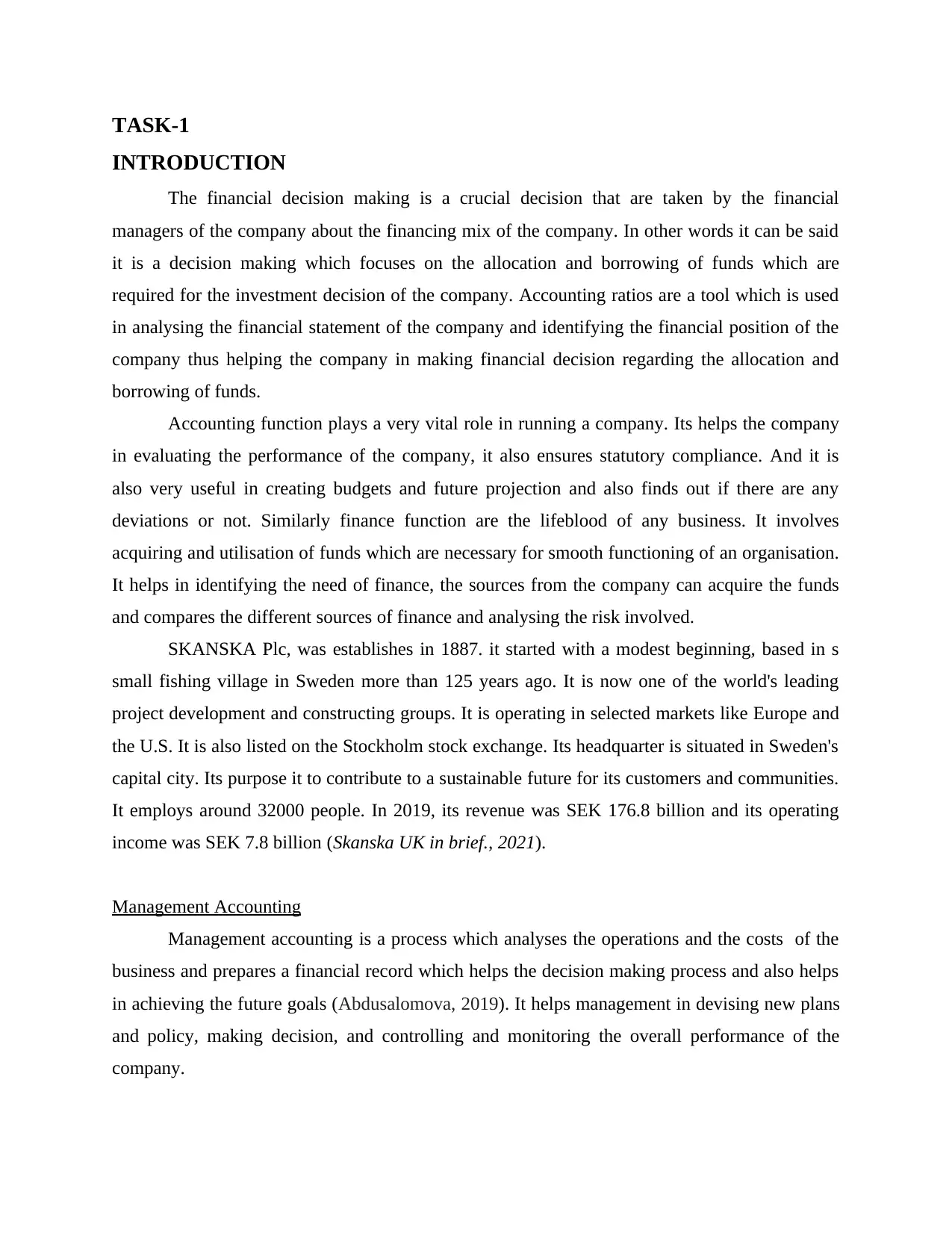
TASK-1
INTRODUCTION
The financial decision making is a crucial decision that are taken by the financial
managers of the company about the financing mix of the company. In other words it can be said
it is a decision making which focuses on the allocation and borrowing of funds which are
required for the investment decision of the company. Accounting ratios are a tool which is used
in analysing the financial statement of the company and identifying the financial position of the
company thus helping the company in making financial decision regarding the allocation and
borrowing of funds.
Accounting function plays a very vital role in running a company. Its helps the company
in evaluating the performance of the company, it also ensures statutory compliance. And it is
also very useful in creating budgets and future projection and also finds out if there are any
deviations or not. Similarly finance function are the lifeblood of any business. It involves
acquiring and utilisation of funds which are necessary for smooth functioning of an organisation.
It helps in identifying the need of finance, the sources from the company can acquire the funds
and compares the different sources of finance and analysing the risk involved.
SKANSKA Plc, was establishes in 1887. it started with a modest beginning, based in s
small fishing village in Sweden more than 125 years ago. It is now one of the world's leading
project development and constructing groups. It is operating in selected markets like Europe and
the U.S. It is also listed on the Stockholm stock exchange. Its headquarter is situated in Sweden's
capital city. Its purpose it to contribute to a sustainable future for its customers and communities.
It employs around 32000 people. In 2019, its revenue was SEK 176.8 billion and its operating
income was SEK 7.8 billion (Skanska UK in brief., 2021).
Management Accounting
Management accounting is a process which analyses the operations and the costs of the
business and prepares a financial record which helps the decision making process and also helps
in achieving the future goals (Abdusalomova, 2019). It helps management in devising new plans
and policy, making decision, and controlling and monitoring the overall performance of the
company.
INTRODUCTION
The financial decision making is a crucial decision that are taken by the financial
managers of the company about the financing mix of the company. In other words it can be said
it is a decision making which focuses on the allocation and borrowing of funds which are
required for the investment decision of the company. Accounting ratios are a tool which is used
in analysing the financial statement of the company and identifying the financial position of the
company thus helping the company in making financial decision regarding the allocation and
borrowing of funds.
Accounting function plays a very vital role in running a company. Its helps the company
in evaluating the performance of the company, it also ensures statutory compliance. And it is
also very useful in creating budgets and future projection and also finds out if there are any
deviations or not. Similarly finance function are the lifeblood of any business. It involves
acquiring and utilisation of funds which are necessary for smooth functioning of an organisation.
It helps in identifying the need of finance, the sources from the company can acquire the funds
and compares the different sources of finance and analysing the risk involved.
SKANSKA Plc, was establishes in 1887. it started with a modest beginning, based in s
small fishing village in Sweden more than 125 years ago. It is now one of the world's leading
project development and constructing groups. It is operating in selected markets like Europe and
the U.S. It is also listed on the Stockholm stock exchange. Its headquarter is situated in Sweden's
capital city. Its purpose it to contribute to a sustainable future for its customers and communities.
It employs around 32000 people. In 2019, its revenue was SEK 176.8 billion and its operating
income was SEK 7.8 billion (Skanska UK in brief., 2021).
Management Accounting
Management accounting is a process which analyses the operations and the costs of the
business and prepares a financial record which helps the decision making process and also helps
in achieving the future goals (Abdusalomova, 2019). It helps management in devising new plans
and policy, making decision, and controlling and monitoring the overall performance of the
company.
⊘ This is a preview!⊘
Do you want full access?
Subscribe today to unlock all pages.

Trusted by 1+ million students worldwide
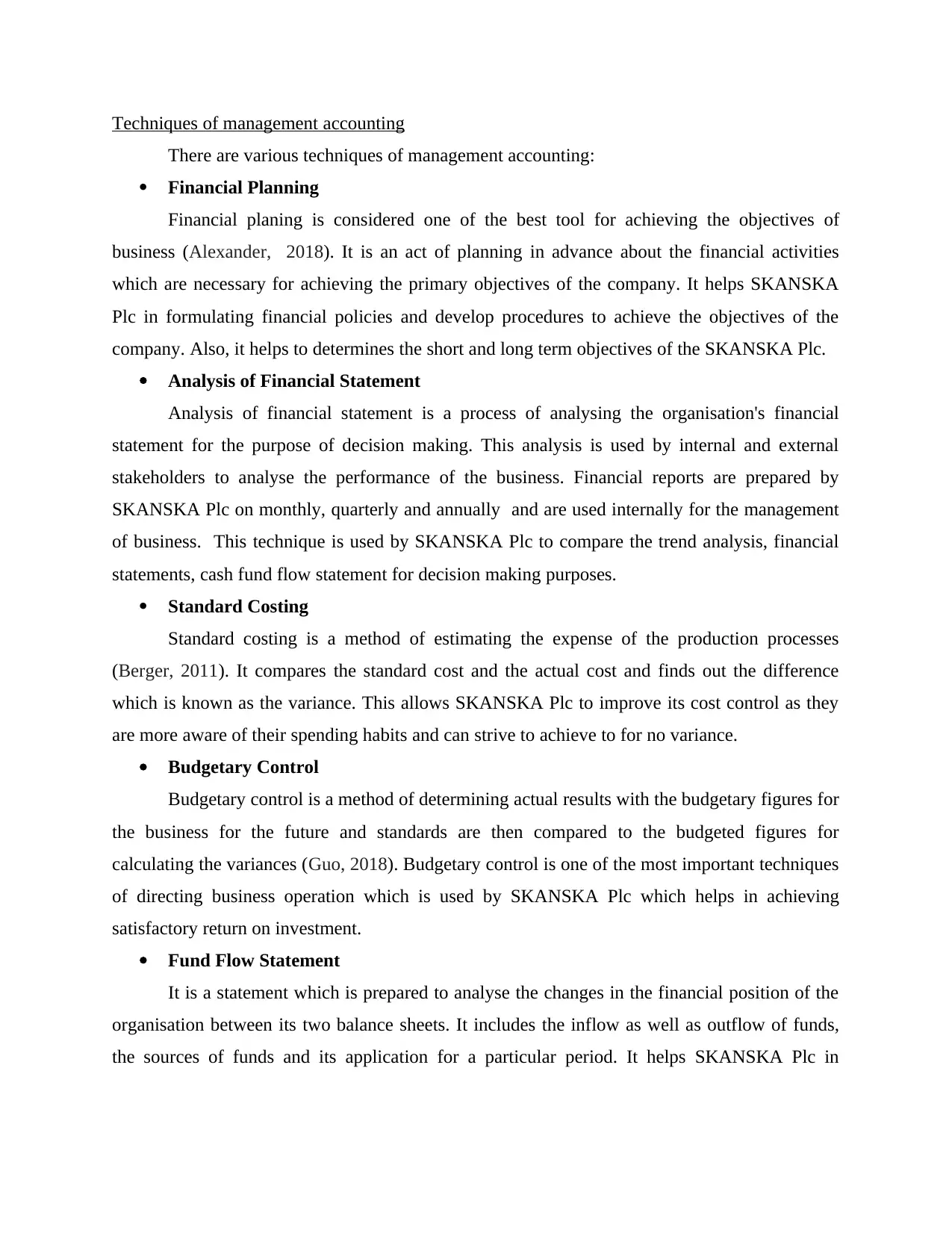
Techniques of management accounting
There are various techniques of management accounting:
Financial Planning
Financial planing is considered one of the best tool for achieving the objectives of
business (Alexander, 2018). It is an act of planning in advance about the financial activities
which are necessary for achieving the primary objectives of the company. It helps SKANSKA
Plc in formulating financial policies and develop procedures to achieve the objectives of the
company. Also, it helps to determines the short and long term objectives of the SKANSKA Plc.
Analysis of Financial Statement
Analysis of financial statement is a process of analysing the organisation's financial
statement for the purpose of decision making. This analysis is used by internal and external
stakeholders to analyse the performance of the business. Financial reports are prepared by
SKANSKA Plc on monthly, quarterly and annually and are used internally for the management
of business. This technique is used by SKANSKA Plc to compare the trend analysis, financial
statements, cash fund flow statement for decision making purposes.
Standard Costing
Standard costing is a method of estimating the expense of the production processes
(Berger, 2011). It compares the standard cost and the actual cost and finds out the difference
which is known as the variance. This allows SKANSKA Plc to improve its cost control as they
are more aware of their spending habits and can strive to achieve to for no variance.
Budgetary Control
Budgetary control is a method of determining actual results with the budgetary figures for
the business for the future and standards are then compared to the budgeted figures for
calculating the variances (Guo, 2018). Budgetary control is one of the most important techniques
of directing business operation which is used by SKANSKA Plc which helps in achieving
satisfactory return on investment.
Fund Flow Statement
It is a statement which is prepared to analyse the changes in the financial position of the
organisation between its two balance sheets. It includes the inflow as well as outflow of funds,
the sources of funds and its application for a particular period. It helps SKANSKA Plc in
There are various techniques of management accounting:
Financial Planning
Financial planing is considered one of the best tool for achieving the objectives of
business (Alexander, 2018). It is an act of planning in advance about the financial activities
which are necessary for achieving the primary objectives of the company. It helps SKANSKA
Plc in formulating financial policies and develop procedures to achieve the objectives of the
company. Also, it helps to determines the short and long term objectives of the SKANSKA Plc.
Analysis of Financial Statement
Analysis of financial statement is a process of analysing the organisation's financial
statement for the purpose of decision making. This analysis is used by internal and external
stakeholders to analyse the performance of the business. Financial reports are prepared by
SKANSKA Plc on monthly, quarterly and annually and are used internally for the management
of business. This technique is used by SKANSKA Plc to compare the trend analysis, financial
statements, cash fund flow statement for decision making purposes.
Standard Costing
Standard costing is a method of estimating the expense of the production processes
(Berger, 2011). It compares the standard cost and the actual cost and finds out the difference
which is known as the variance. This allows SKANSKA Plc to improve its cost control as they
are more aware of their spending habits and can strive to achieve to for no variance.
Budgetary Control
Budgetary control is a method of determining actual results with the budgetary figures for
the business for the future and standards are then compared to the budgeted figures for
calculating the variances (Guo, 2018). Budgetary control is one of the most important techniques
of directing business operation which is used by SKANSKA Plc which helps in achieving
satisfactory return on investment.
Fund Flow Statement
It is a statement which is prepared to analyse the changes in the financial position of the
organisation between its two balance sheets. It includes the inflow as well as outflow of funds,
the sources of funds and its application for a particular period. It helps SKANSKA Plc in
Paraphrase This Document
Need a fresh take? Get an instant paraphrase of this document with our AI Paraphraser
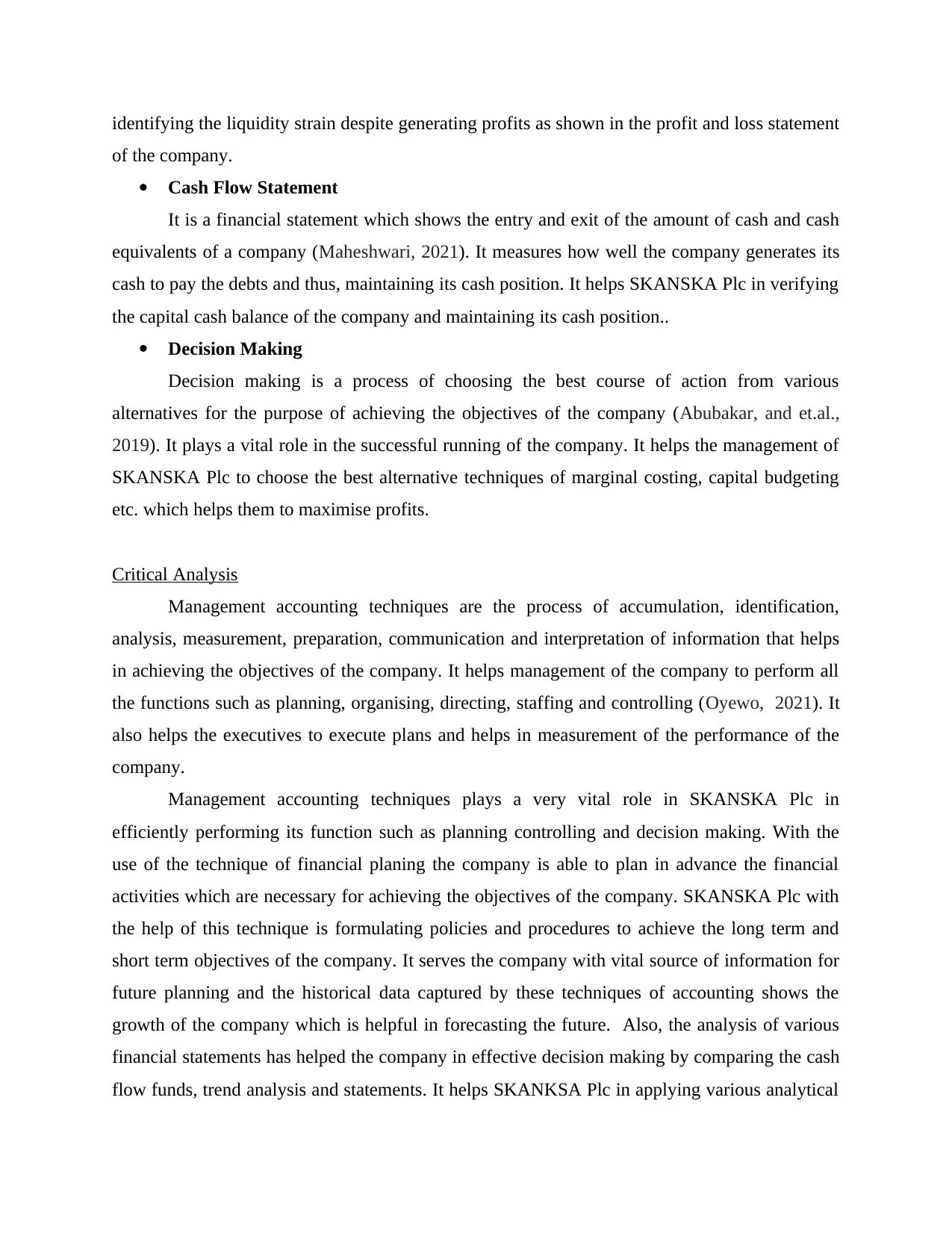
identifying the liquidity strain despite generating profits as shown in the profit and loss statement
of the company.
Cash Flow Statement
It is a financial statement which shows the entry and exit of the amount of cash and cash
equivalents of a company (Maheshwari, 2021). It measures how well the company generates its
cash to pay the debts and thus, maintaining its cash position. It helps SKANSKA Plc in verifying
the capital cash balance of the company and maintaining its cash position..
Decision Making
Decision making is a process of choosing the best course of action from various
alternatives for the purpose of achieving the objectives of the company (Abubakar, and et.al.,
2019). It plays a vital role in the successful running of the company. It helps the management of
SKANSKA Plc to choose the best alternative techniques of marginal costing, capital budgeting
etc. which helps them to maximise profits.
Critical Analysis
Management accounting techniques are the process of accumulation, identification,
analysis, measurement, preparation, communication and interpretation of information that helps
in achieving the objectives of the company. It helps management of the company to perform all
the functions such as planning, organising, directing, staffing and controlling (Oyewo, 2021). It
also helps the executives to execute plans and helps in measurement of the performance of the
company.
Management accounting techniques plays a very vital role in SKANSKA Plc in
efficiently performing its function such as planning controlling and decision making. With the
use of the technique of financial planing the company is able to plan in advance the financial
activities which are necessary for achieving the objectives of the company. SKANSKA Plc with
the help of this technique is formulating policies and procedures to achieve the long term and
short term objectives of the company. It serves the company with vital source of information for
future planning and the historical data captured by these techniques of accounting shows the
growth of the company which is helpful in forecasting the future. Also, the analysis of various
financial statements has helped the company in effective decision making by comparing the cash
flow funds, trend analysis and statements. It helps SKANKSA Plc in applying various analytical
of the company.
Cash Flow Statement
It is a financial statement which shows the entry and exit of the amount of cash and cash
equivalents of a company (Maheshwari, 2021). It measures how well the company generates its
cash to pay the debts and thus, maintaining its cash position. It helps SKANSKA Plc in verifying
the capital cash balance of the company and maintaining its cash position..
Decision Making
Decision making is a process of choosing the best course of action from various
alternatives for the purpose of achieving the objectives of the company (Abubakar, and et.al.,
2019). It plays a vital role in the successful running of the company. It helps the management of
SKANSKA Plc to choose the best alternative techniques of marginal costing, capital budgeting
etc. which helps them to maximise profits.
Critical Analysis
Management accounting techniques are the process of accumulation, identification,
analysis, measurement, preparation, communication and interpretation of information that helps
in achieving the objectives of the company. It helps management of the company to perform all
the functions such as planning, organising, directing, staffing and controlling (Oyewo, 2021). It
also helps the executives to execute plans and helps in measurement of the performance of the
company.
Management accounting techniques plays a very vital role in SKANSKA Plc in
efficiently performing its function such as planning controlling and decision making. With the
use of the technique of financial planing the company is able to plan in advance the financial
activities which are necessary for achieving the objectives of the company. SKANSKA Plc with
the help of this technique is formulating policies and procedures to achieve the long term and
short term objectives of the company. It serves the company with vital source of information for
future planning and the historical data captured by these techniques of accounting shows the
growth of the company which is helpful in forecasting the future. Also, the analysis of various
financial statements has helped the company in effective decision making by comparing the cash
flow funds, trend analysis and statements. It helps SKANKSA Plc in applying various analytical
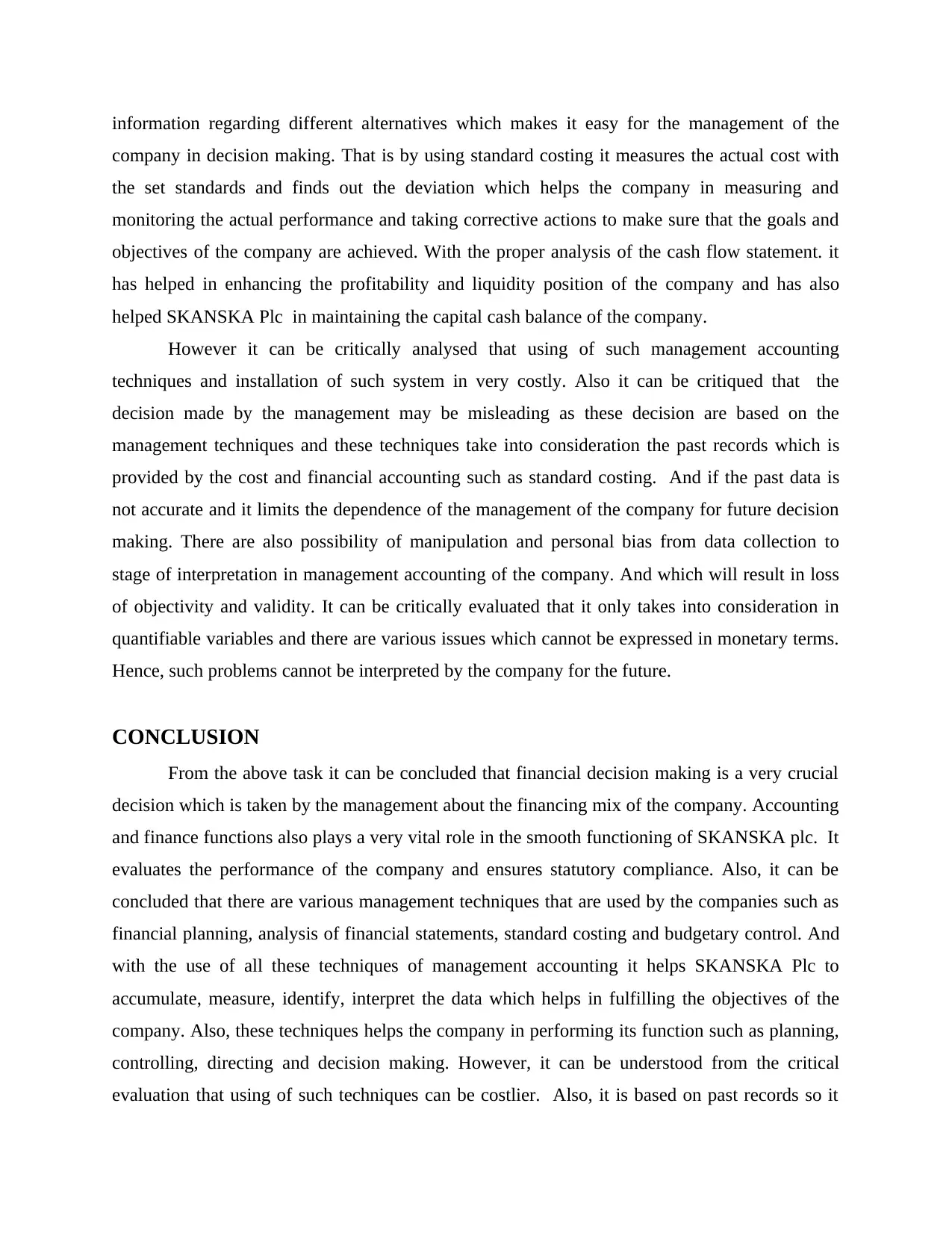
information regarding different alternatives which makes it easy for the management of the
company in decision making. That is by using standard costing it measures the actual cost with
the set standards and finds out the deviation which helps the company in measuring and
monitoring the actual performance and taking corrective actions to make sure that the goals and
objectives of the company are achieved. With the proper analysis of the cash flow statement. it
has helped in enhancing the profitability and liquidity position of the company and has also
helped SKANSKA Plc in maintaining the capital cash balance of the company.
However it can be critically analysed that using of such management accounting
techniques and installation of such system in very costly. Also it can be critiqued that the
decision made by the management may be misleading as these decision are based on the
management techniques and these techniques take into consideration the past records which is
provided by the cost and financial accounting such as standard costing. And if the past data is
not accurate and it limits the dependence of the management of the company for future decision
making. There are also possibility of manipulation and personal bias from data collection to
stage of interpretation in management accounting of the company. And which will result in loss
of objectivity and validity. It can be critically evaluated that it only takes into consideration in
quantifiable variables and there are various issues which cannot be expressed in monetary terms.
Hence, such problems cannot be interpreted by the company for the future.
CONCLUSION
From the above task it can be concluded that financial decision making is a very crucial
decision which is taken by the management about the financing mix of the company. Accounting
and finance functions also plays a very vital role in the smooth functioning of SKANSKA plc. It
evaluates the performance of the company and ensures statutory compliance. Also, it can be
concluded that there are various management techniques that are used by the companies such as
financial planning, analysis of financial statements, standard costing and budgetary control. And
with the use of all these techniques of management accounting it helps SKANSKA Plc to
accumulate, measure, identify, interpret the data which helps in fulfilling the objectives of the
company. Also, these techniques helps the company in performing its function such as planning,
controlling, directing and decision making. However, it can be understood from the critical
evaluation that using of such techniques can be costlier. Also, it is based on past records so it
company in decision making. That is by using standard costing it measures the actual cost with
the set standards and finds out the deviation which helps the company in measuring and
monitoring the actual performance and taking corrective actions to make sure that the goals and
objectives of the company are achieved. With the proper analysis of the cash flow statement. it
has helped in enhancing the profitability and liquidity position of the company and has also
helped SKANSKA Plc in maintaining the capital cash balance of the company.
However it can be critically analysed that using of such management accounting
techniques and installation of such system in very costly. Also it can be critiqued that the
decision made by the management may be misleading as these decision are based on the
management techniques and these techniques take into consideration the past records which is
provided by the cost and financial accounting such as standard costing. And if the past data is
not accurate and it limits the dependence of the management of the company for future decision
making. There are also possibility of manipulation and personal bias from data collection to
stage of interpretation in management accounting of the company. And which will result in loss
of objectivity and validity. It can be critically evaluated that it only takes into consideration in
quantifiable variables and there are various issues which cannot be expressed in monetary terms.
Hence, such problems cannot be interpreted by the company for the future.
CONCLUSION
From the above task it can be concluded that financial decision making is a very crucial
decision which is taken by the management about the financing mix of the company. Accounting
and finance functions also plays a very vital role in the smooth functioning of SKANSKA plc. It
evaluates the performance of the company and ensures statutory compliance. Also, it can be
concluded that there are various management techniques that are used by the companies such as
financial planning, analysis of financial statements, standard costing and budgetary control. And
with the use of all these techniques of management accounting it helps SKANSKA Plc to
accumulate, measure, identify, interpret the data which helps in fulfilling the objectives of the
company. Also, these techniques helps the company in performing its function such as planning,
controlling, directing and decision making. However, it can be understood from the critical
evaluation that using of such techniques can be costlier. Also, it is based on past records so it
⊘ This is a preview!⊘
Do you want full access?
Subscribe today to unlock all pages.

Trusted by 1+ million students worldwide
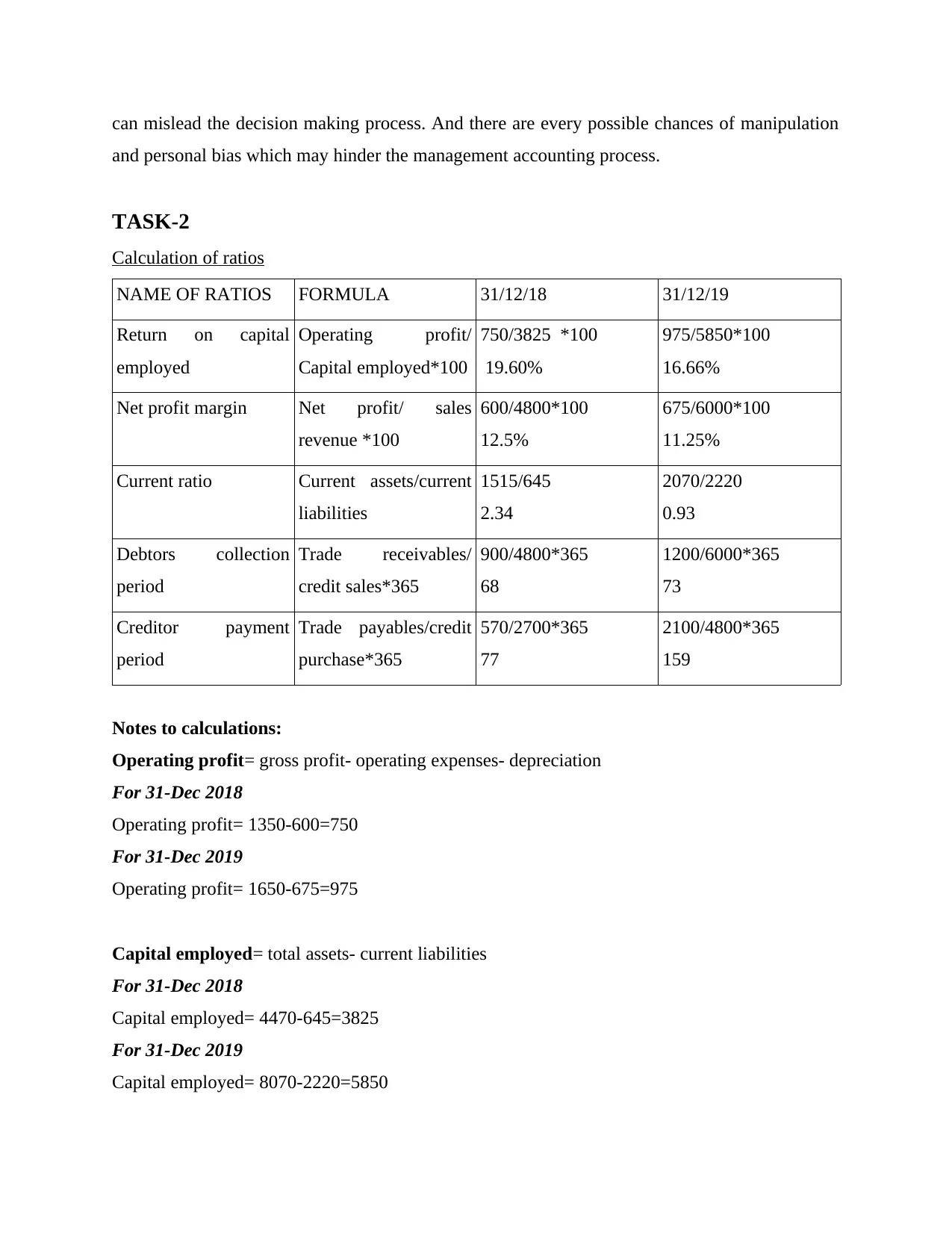
can mislead the decision making process. And there are every possible chances of manipulation
and personal bias which may hinder the management accounting process.
TASK-2
Calculation of ratios
NAME OF RATIOS FORMULA 31/12/18 31/12/19
Return on capital
employed
Operating profit/
Capital employed*100
750/3825 *100
19.60%
975/5850*100
16.66%
Net profit margin Net profit/ sales
revenue *100
600/4800*100
12.5%
675/6000*100
11.25%
Current ratio Current assets/current
liabilities
1515/645
2.34
2070/2220
0.93
Debtors collection
period
Trade receivables/
credit sales*365
900/4800*365
68
1200/6000*365
73
Creditor payment
period
Trade payables/credit
purchase*365
570/2700*365
77
2100/4800*365
159
Notes to calculations:
Operating profit= gross profit- operating expenses- depreciation
For 31-Dec 2018
Operating profit= 1350-600=750
For 31-Dec 2019
Operating profit= 1650-675=975
Capital employed= total assets- current liabilities
For 31-Dec 2018
Capital employed= 4470-645=3825
For 31-Dec 2019
Capital employed= 8070-2220=5850
and personal bias which may hinder the management accounting process.
TASK-2
Calculation of ratios
NAME OF RATIOS FORMULA 31/12/18 31/12/19
Return on capital
employed
Operating profit/
Capital employed*100
750/3825 *100
19.60%
975/5850*100
16.66%
Net profit margin Net profit/ sales
revenue *100
600/4800*100
12.5%
675/6000*100
11.25%
Current ratio Current assets/current
liabilities
1515/645
2.34
2070/2220
0.93
Debtors collection
period
Trade receivables/
credit sales*365
900/4800*365
68
1200/6000*365
73
Creditor payment
period
Trade payables/credit
purchase*365
570/2700*365
77
2100/4800*365
159
Notes to calculations:
Operating profit= gross profit- operating expenses- depreciation
For 31-Dec 2018
Operating profit= 1350-600=750
For 31-Dec 2019
Operating profit= 1650-675=975
Capital employed= total assets- current liabilities
For 31-Dec 2018
Capital employed= 4470-645=3825
For 31-Dec 2019
Capital employed= 8070-2220=5850
Paraphrase This Document
Need a fresh take? Get an instant paraphrase of this document with our AI Paraphraser
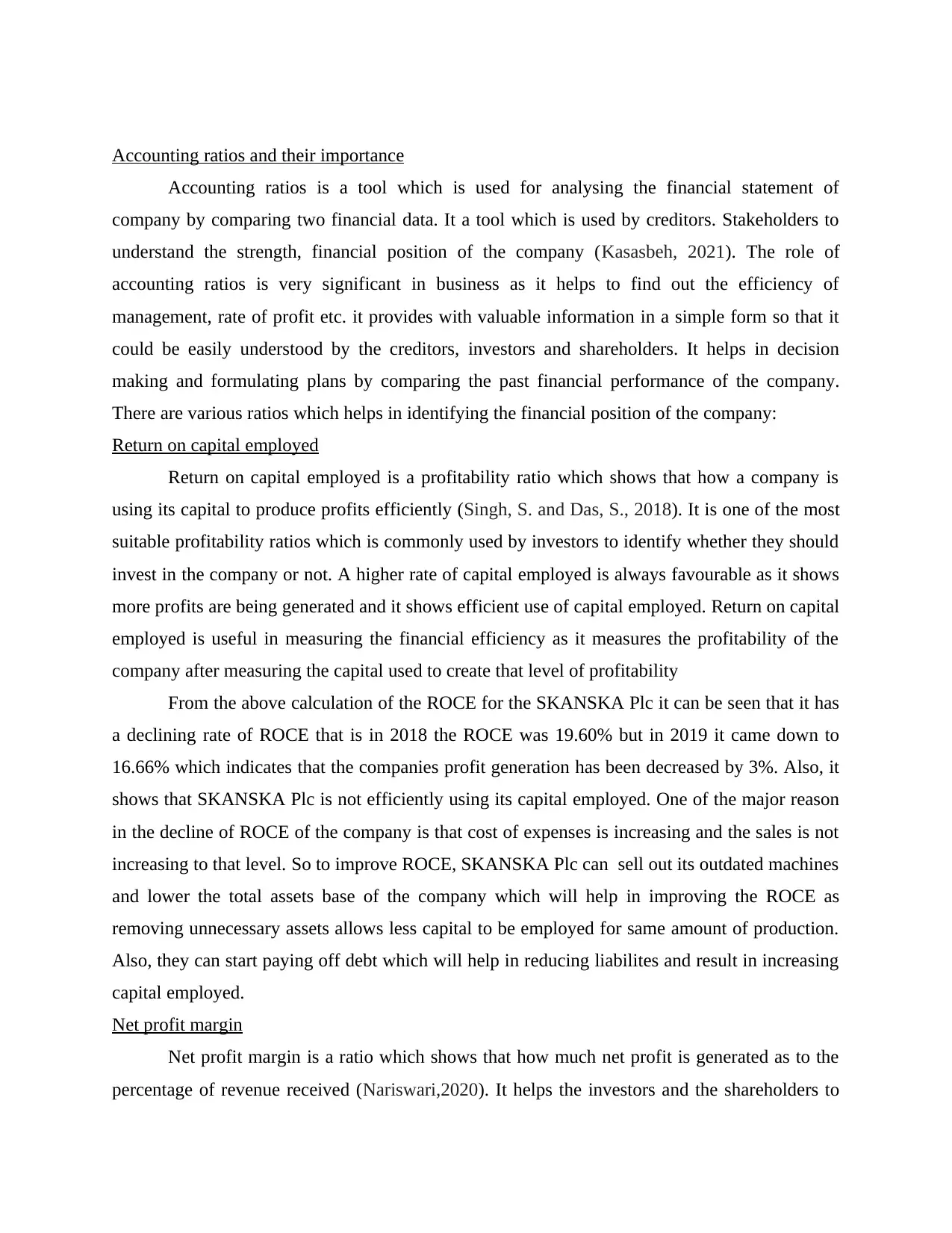
Accounting ratios and their importance
Accounting ratios is a tool which is used for analysing the financial statement of
company by comparing two financial data. It a tool which is used by creditors. Stakeholders to
understand the strength, financial position of the company (Kasasbeh, 2021). The role of
accounting ratios is very significant in business as it helps to find out the efficiency of
management, rate of profit etc. it provides with valuable information in a simple form so that it
could be easily understood by the creditors, investors and shareholders. It helps in decision
making and formulating plans by comparing the past financial performance of the company.
There are various ratios which helps in identifying the financial position of the company:
Return on capital employed
Return on capital employed is a profitability ratio which shows that how a company is
using its capital to produce profits efficiently (Singh, S. and Das, S., 2018). It is one of the most
suitable profitability ratios which is commonly used by investors to identify whether they should
invest in the company or not. A higher rate of capital employed is always favourable as it shows
more profits are being generated and it shows efficient use of capital employed. Return on capital
employed is useful in measuring the financial efficiency as it measures the profitability of the
company after measuring the capital used to create that level of profitability
From the above calculation of the ROCE for the SKANSKA Plc it can be seen that it has
a declining rate of ROCE that is in 2018 the ROCE was 19.60% but in 2019 it came down to
16.66% which indicates that the companies profit generation has been decreased by 3%. Also, it
shows that SKANSKA Plc is not efficiently using its capital employed. One of the major reason
in the decline of ROCE of the company is that cost of expenses is increasing and the sales is not
increasing to that level. So to improve ROCE, SKANSKA Plc can sell out its outdated machines
and lower the total assets base of the company which will help in improving the ROCE as
removing unnecessary assets allows less capital to be employed for same amount of production.
Also, they can start paying off debt which will help in reducing liabilites and result in increasing
capital employed.
Net profit margin
Net profit margin is a ratio which shows that how much net profit is generated as to the
percentage of revenue received (Nariswari,2020). It helps the investors and the shareholders to
Accounting ratios is a tool which is used for analysing the financial statement of
company by comparing two financial data. It a tool which is used by creditors. Stakeholders to
understand the strength, financial position of the company (Kasasbeh, 2021). The role of
accounting ratios is very significant in business as it helps to find out the efficiency of
management, rate of profit etc. it provides with valuable information in a simple form so that it
could be easily understood by the creditors, investors and shareholders. It helps in decision
making and formulating plans by comparing the past financial performance of the company.
There are various ratios which helps in identifying the financial position of the company:
Return on capital employed
Return on capital employed is a profitability ratio which shows that how a company is
using its capital to produce profits efficiently (Singh, S. and Das, S., 2018). It is one of the most
suitable profitability ratios which is commonly used by investors to identify whether they should
invest in the company or not. A higher rate of capital employed is always favourable as it shows
more profits are being generated and it shows efficient use of capital employed. Return on capital
employed is useful in measuring the financial efficiency as it measures the profitability of the
company after measuring the capital used to create that level of profitability
From the above calculation of the ROCE for the SKANSKA Plc it can be seen that it has
a declining rate of ROCE that is in 2018 the ROCE was 19.60% but in 2019 it came down to
16.66% which indicates that the companies profit generation has been decreased by 3%. Also, it
shows that SKANSKA Plc is not efficiently using its capital employed. One of the major reason
in the decline of ROCE of the company is that cost of expenses is increasing and the sales is not
increasing to that level. So to improve ROCE, SKANSKA Plc can sell out its outdated machines
and lower the total assets base of the company which will help in improving the ROCE as
removing unnecessary assets allows less capital to be employed for same amount of production.
Also, they can start paying off debt which will help in reducing liabilites and result in increasing
capital employed.
Net profit margin
Net profit margin is a ratio which shows that how much net profit is generated as to the
percentage of revenue received (Nariswari,2020). It helps the investors and the shareholders to
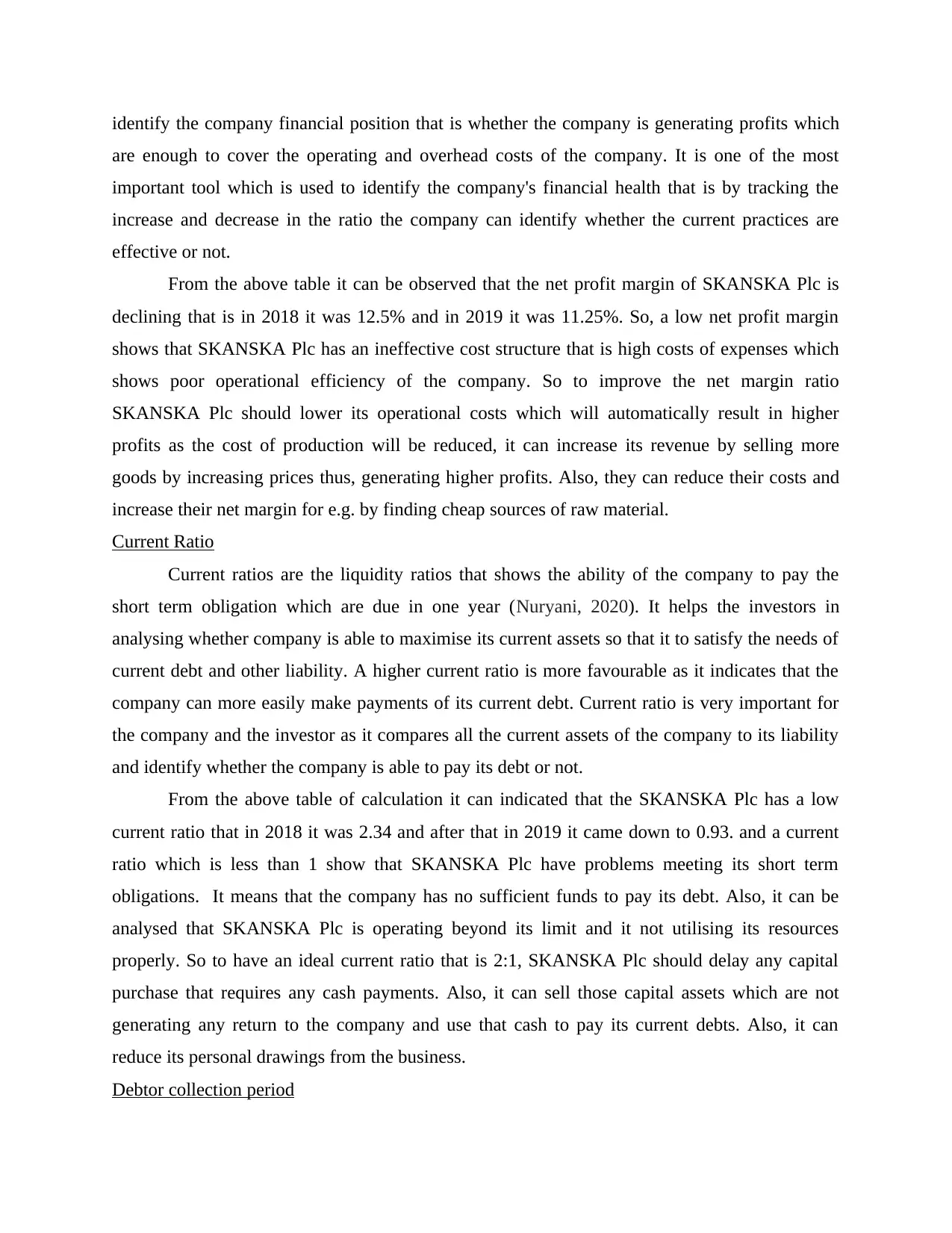
identify the company financial position that is whether the company is generating profits which
are enough to cover the operating and overhead costs of the company. It is one of the most
important tool which is used to identify the company's financial health that is by tracking the
increase and decrease in the ratio the company can identify whether the current practices are
effective or not.
From the above table it can be observed that the net profit margin of SKANSKA Plc is
declining that is in 2018 it was 12.5% and in 2019 it was 11.25%. So, a low net profit margin
shows that SKANSKA Plc has an ineffective cost structure that is high costs of expenses which
shows poor operational efficiency of the company. So to improve the net margin ratio
SKANSKA Plc should lower its operational costs which will automatically result in higher
profits as the cost of production will be reduced, it can increase its revenue by selling more
goods by increasing prices thus, generating higher profits. Also, they can reduce their costs and
increase their net margin for e.g. by finding cheap sources of raw material.
Current Ratio
Current ratios are the liquidity ratios that shows the ability of the company to pay the
short term obligation which are due in one year (Nuryani, 2020). It helps the investors in
analysing whether company is able to maximise its current assets so that it to satisfy the needs of
current debt and other liability. A higher current ratio is more favourable as it indicates that the
company can more easily make payments of its current debt. Current ratio is very important for
the company and the investor as it compares all the current assets of the company to its liability
and identify whether the company is able to pay its debt or not.
From the above table of calculation it can indicated that the SKANSKA Plc has a low
current ratio that in 2018 it was 2.34 and after that in 2019 it came down to 0.93. and a current
ratio which is less than 1 show that SKANSKA Plc have problems meeting its short term
obligations. It means that the company has no sufficient funds to pay its debt. Also, it can be
analysed that SKANSKA Plc is operating beyond its limit and it not utilising its resources
properly. So to have an ideal current ratio that is 2:1, SKANSKA Plc should delay any capital
purchase that requires any cash payments. Also, it can sell those capital assets which are not
generating any return to the company and use that cash to pay its current debts. Also, it can
reduce its personal drawings from the business.
Debtor collection period
are enough to cover the operating and overhead costs of the company. It is one of the most
important tool which is used to identify the company's financial health that is by tracking the
increase and decrease in the ratio the company can identify whether the current practices are
effective or not.
From the above table it can be observed that the net profit margin of SKANSKA Plc is
declining that is in 2018 it was 12.5% and in 2019 it was 11.25%. So, a low net profit margin
shows that SKANSKA Plc has an ineffective cost structure that is high costs of expenses which
shows poor operational efficiency of the company. So to improve the net margin ratio
SKANSKA Plc should lower its operational costs which will automatically result in higher
profits as the cost of production will be reduced, it can increase its revenue by selling more
goods by increasing prices thus, generating higher profits. Also, they can reduce their costs and
increase their net margin for e.g. by finding cheap sources of raw material.
Current Ratio
Current ratios are the liquidity ratios that shows the ability of the company to pay the
short term obligation which are due in one year (Nuryani, 2020). It helps the investors in
analysing whether company is able to maximise its current assets so that it to satisfy the needs of
current debt and other liability. A higher current ratio is more favourable as it indicates that the
company can more easily make payments of its current debt. Current ratio is very important for
the company and the investor as it compares all the current assets of the company to its liability
and identify whether the company is able to pay its debt or not.
From the above table of calculation it can indicated that the SKANSKA Plc has a low
current ratio that in 2018 it was 2.34 and after that in 2019 it came down to 0.93. and a current
ratio which is less than 1 show that SKANSKA Plc have problems meeting its short term
obligations. It means that the company has no sufficient funds to pay its debt. Also, it can be
analysed that SKANSKA Plc is operating beyond its limit and it not utilising its resources
properly. So to have an ideal current ratio that is 2:1, SKANSKA Plc should delay any capital
purchase that requires any cash payments. Also, it can sell those capital assets which are not
generating any return to the company and use that cash to pay its current debts. Also, it can
reduce its personal drawings from the business.
Debtor collection period
⊘ This is a preview!⊘
Do you want full access?
Subscribe today to unlock all pages.

Trusted by 1+ million students worldwide
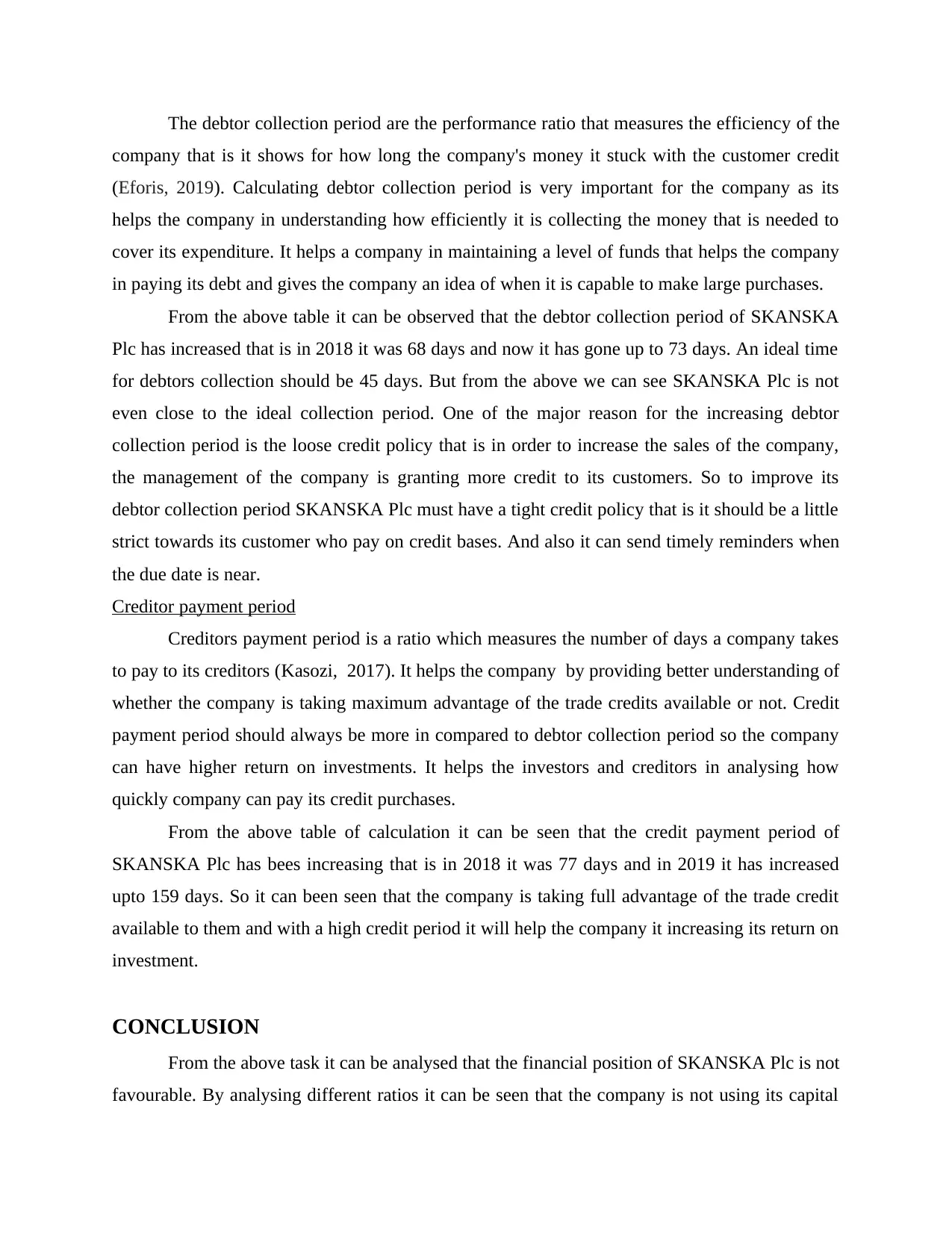
The debtor collection period are the performance ratio that measures the efficiency of the
company that is it shows for how long the company's money it stuck with the customer credit
(Eforis, 2019). Calculating debtor collection period is very important for the company as its
helps the company in understanding how efficiently it is collecting the money that is needed to
cover its expenditure. It helps a company in maintaining a level of funds that helps the company
in paying its debt and gives the company an idea of when it is capable to make large purchases.
From the above table it can be observed that the debtor collection period of SKANSKA
Plc has increased that is in 2018 it was 68 days and now it has gone up to 73 days. An ideal time
for debtors collection should be 45 days. But from the above we can see SKANSKA Plc is not
even close to the ideal collection period. One of the major reason for the increasing debtor
collection period is the loose credit policy that is in order to increase the sales of the company,
the management of the company is granting more credit to its customers. So to improve its
debtor collection period SKANSKA Plc must have a tight credit policy that is it should be a little
strict towards its customer who pay on credit bases. And also it can send timely reminders when
the due date is near.
Creditor payment period
Creditors payment period is a ratio which measures the number of days a company takes
to pay to its creditors (Kasozi, 2017). It helps the company by providing better understanding of
whether the company is taking maximum advantage of the trade credits available or not. Credit
payment period should always be more in compared to debtor collection period so the company
can have higher return on investments. It helps the investors and creditors in analysing how
quickly company can pay its credit purchases.
From the above table of calculation it can be seen that the credit payment period of
SKANSKA Plc has bees increasing that is in 2018 it was 77 days and in 2019 it has increased
upto 159 days. So it can been seen that the company is taking full advantage of the trade credit
available to them and with a high credit period it will help the company it increasing its return on
investment.
CONCLUSION
From the above task it can be analysed that the financial position of SKANSKA Plc is not
favourable. By analysing different ratios it can be seen that the company is not using its capital
company that is it shows for how long the company's money it stuck with the customer credit
(Eforis, 2019). Calculating debtor collection period is very important for the company as its
helps the company in understanding how efficiently it is collecting the money that is needed to
cover its expenditure. It helps a company in maintaining a level of funds that helps the company
in paying its debt and gives the company an idea of when it is capable to make large purchases.
From the above table it can be observed that the debtor collection period of SKANSKA
Plc has increased that is in 2018 it was 68 days and now it has gone up to 73 days. An ideal time
for debtors collection should be 45 days. But from the above we can see SKANSKA Plc is not
even close to the ideal collection period. One of the major reason for the increasing debtor
collection period is the loose credit policy that is in order to increase the sales of the company,
the management of the company is granting more credit to its customers. So to improve its
debtor collection period SKANSKA Plc must have a tight credit policy that is it should be a little
strict towards its customer who pay on credit bases. And also it can send timely reminders when
the due date is near.
Creditor payment period
Creditors payment period is a ratio which measures the number of days a company takes
to pay to its creditors (Kasozi, 2017). It helps the company by providing better understanding of
whether the company is taking maximum advantage of the trade credits available or not. Credit
payment period should always be more in compared to debtor collection period so the company
can have higher return on investments. It helps the investors and creditors in analysing how
quickly company can pay its credit purchases.
From the above table of calculation it can be seen that the credit payment period of
SKANSKA Plc has bees increasing that is in 2018 it was 77 days and in 2019 it has increased
upto 159 days. So it can been seen that the company is taking full advantage of the trade credit
available to them and with a high credit period it will help the company it increasing its return on
investment.
CONCLUSION
From the above task it can be analysed that the financial position of SKANSKA Plc is not
favourable. By analysing different ratios it can be seen that the company is not using its capital
Paraphrase This Document
Need a fresh take? Get an instant paraphrase of this document with our AI Paraphraser
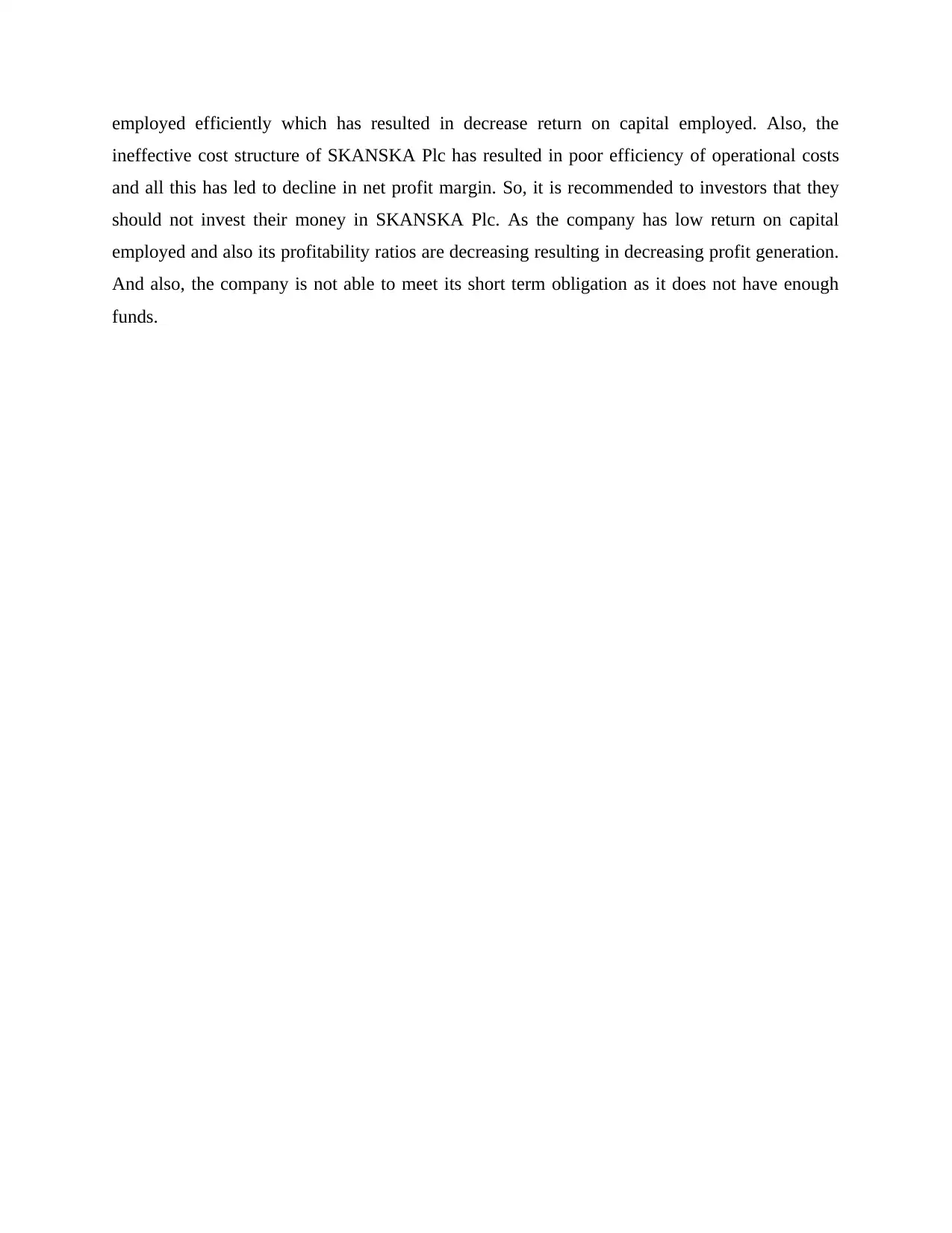
employed efficiently which has resulted in decrease return on capital employed. Also, the
ineffective cost structure of SKANSKA Plc has resulted in poor efficiency of operational costs
and all this has led to decline in net profit margin. So, it is recommended to investors that they
should not invest their money in SKANSKA Plc. As the company has low return on capital
employed and also its profitability ratios are decreasing resulting in decreasing profit generation.
And also, the company is not able to meet its short term obligation as it does not have enough
funds.
ineffective cost structure of SKANSKA Plc has resulted in poor efficiency of operational costs
and all this has led to decline in net profit margin. So, it is recommended to investors that they
should not invest their money in SKANSKA Plc. As the company has low return on capital
employed and also its profitability ratios are decreasing resulting in decreasing profit generation.
And also, the company is not able to meet its short term obligation as it does not have enough
funds.
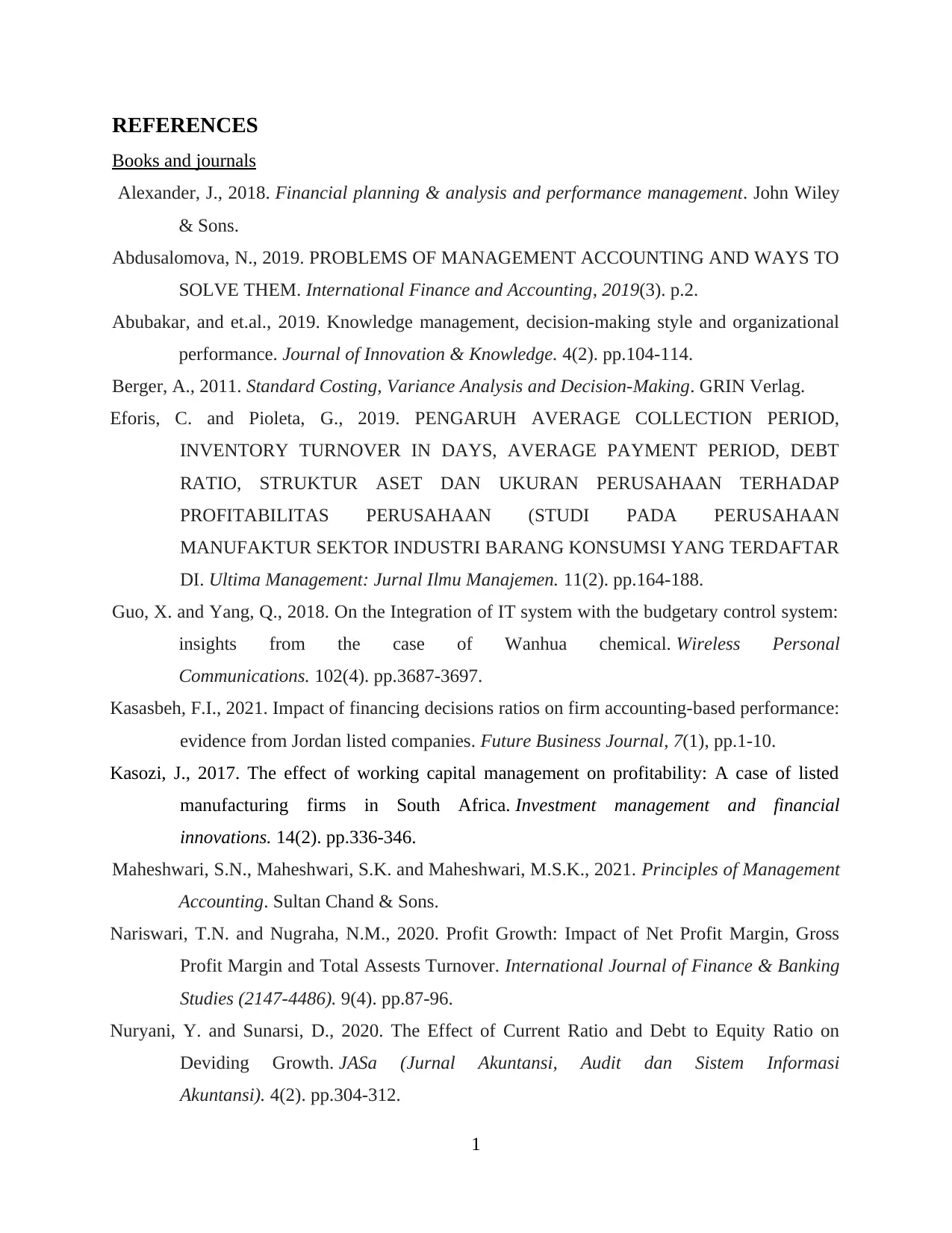
REFERENCES
Books and journals
Alexander, J., 2018. Financial planning & analysis and performance management. John Wiley
& Sons.
Abdusalomova, N., 2019. PROBLEMS OF MANAGEMENT ACCOUNTING AND WAYS TO
SOLVE THEM. International Finance and Accounting, 2019(3). p.2.
Abubakar, and et.al., 2019. Knowledge management, decision-making style and organizational
performance. Journal of Innovation & Knowledge. 4(2). pp.104-114.
Berger, A., 2011. Standard Costing, Variance Analysis and Decision-Making. GRIN Verlag.
Eforis, C. and Pioleta, G., 2019. PENGARUH AVERAGE COLLECTION PERIOD,
INVENTORY TURNOVER IN DAYS, AVERAGE PAYMENT PERIOD, DEBT
RATIO, STRUKTUR ASET DAN UKURAN PERUSAHAAN TERHADAP
PROFITABILITAS PERUSAHAAN (STUDI PADA PERUSAHAAN
MANUFAKTUR SEKTOR INDUSTRI BARANG KONSUMSI YANG TERDAFTAR
DI. Ultima Management: Jurnal Ilmu Manajemen. 11(2). pp.164-188.
Guo, X. and Yang, Q., 2018. On the Integration of IT system with the budgetary control system:
insights from the case of Wanhua chemical. Wireless Personal
Communications. 102(4). pp.3687-3697.
Kasasbeh, F.I., 2021. Impact of financing decisions ratios on firm accounting-based performance:
evidence from Jordan listed companies. Future Business Journal, 7(1), pp.1-10.
Kasozi, J., 2017. The effect of working capital management on profitability: A case of listed
manufacturing firms in South Africa. Investment management and financial
innovations. 14(2). pp.336-346.
Maheshwari, S.N., Maheshwari, S.K. and Maheshwari, M.S.K., 2021. Principles of Management
Accounting. Sultan Chand & Sons.
Nariswari, T.N. and Nugraha, N.M., 2020. Profit Growth: Impact of Net Profit Margin, Gross
Profit Margin and Total Assests Turnover. International Journal of Finance & Banking
Studies (2147-4486). 9(4). pp.87-96.
Nuryani, Y. and Sunarsi, D., 2020. The Effect of Current Ratio and Debt to Equity Ratio on
Deviding Growth. JASa (Jurnal Akuntansi, Audit dan Sistem Informasi
Akuntansi). 4(2). pp.304-312.
1
Books and journals
Alexander, J., 2018. Financial planning & analysis and performance management. John Wiley
& Sons.
Abdusalomova, N., 2019. PROBLEMS OF MANAGEMENT ACCOUNTING AND WAYS TO
SOLVE THEM. International Finance and Accounting, 2019(3). p.2.
Abubakar, and et.al., 2019. Knowledge management, decision-making style and organizational
performance. Journal of Innovation & Knowledge. 4(2). pp.104-114.
Berger, A., 2011. Standard Costing, Variance Analysis and Decision-Making. GRIN Verlag.
Eforis, C. and Pioleta, G., 2019. PENGARUH AVERAGE COLLECTION PERIOD,
INVENTORY TURNOVER IN DAYS, AVERAGE PAYMENT PERIOD, DEBT
RATIO, STRUKTUR ASET DAN UKURAN PERUSAHAAN TERHADAP
PROFITABILITAS PERUSAHAAN (STUDI PADA PERUSAHAAN
MANUFAKTUR SEKTOR INDUSTRI BARANG KONSUMSI YANG TERDAFTAR
DI. Ultima Management: Jurnal Ilmu Manajemen. 11(2). pp.164-188.
Guo, X. and Yang, Q., 2018. On the Integration of IT system with the budgetary control system:
insights from the case of Wanhua chemical. Wireless Personal
Communications. 102(4). pp.3687-3697.
Kasasbeh, F.I., 2021. Impact of financing decisions ratios on firm accounting-based performance:
evidence from Jordan listed companies. Future Business Journal, 7(1), pp.1-10.
Kasozi, J., 2017. The effect of working capital management on profitability: A case of listed
manufacturing firms in South Africa. Investment management and financial
innovations. 14(2). pp.336-346.
Maheshwari, S.N., Maheshwari, S.K. and Maheshwari, M.S.K., 2021. Principles of Management
Accounting. Sultan Chand & Sons.
Nariswari, T.N. and Nugraha, N.M., 2020. Profit Growth: Impact of Net Profit Margin, Gross
Profit Margin and Total Assests Turnover. International Journal of Finance & Banking
Studies (2147-4486). 9(4). pp.87-96.
Nuryani, Y. and Sunarsi, D., 2020. The Effect of Current Ratio and Debt to Equity Ratio on
Deviding Growth. JASa (Jurnal Akuntansi, Audit dan Sistem Informasi
Akuntansi). 4(2). pp.304-312.
1
⊘ This is a preview!⊘
Do you want full access?
Subscribe today to unlock all pages.

Trusted by 1+ million students worldwide
1 out of 13
Related Documents
Your All-in-One AI-Powered Toolkit for Academic Success.
+13062052269
info@desklib.com
Available 24*7 on WhatsApp / Email
![[object Object]](/_next/static/media/star-bottom.7253800d.svg)
Unlock your academic potential
Copyright © 2020–2025 A2Z Services. All Rights Reserved. Developed and managed by ZUCOL.




